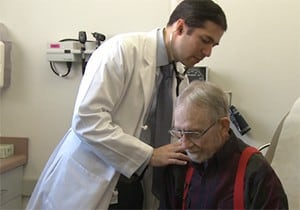UAMS Physicians Save Patient from Aortal Aneurysm Rupture
Dec. 29, 2014 | One day during Thanksgiving week in 2013, Reuben Stuart Ray laid down in his Nashville home expecting to die. Waking up again at all was a surprise, but his surprise grew even bigger when he awoke to realize he was at UAMS Medical Center and expected to live. More than 10 years before, a cardiac surgeon told Ray he had a dissection and thoracic aortic aneurysm, and that there was nothing that could be done. A dissection is a tear inside a blood vessel that can slowly grow and stretch out, forming an enlarged vessel called an aneurysm. Ray’s was in his thoracic aorta, the largest blood vessel in the body. “The doctor said it wasn’t a question of if the aneurysm would burst, but when,” Ray said. He put the problem out of his mind and never asked another physician about it. On that night in November 2013, the question of when the rupture would occur was answered. He awoke feeling nauseated and weak. After vomiting bright, red blood, Ray was convinced that his death was imminent and returned to bed. It was shortly after lying down again, expecting never to get up, that his dog, Boomer, entered his bedroom. “At the time, I had a small dog,” Ray said. “I thought, ‘I can’t just leave Boomer here with me. It might be several days before someone comes by to check on me.’ I called my daughter, and she got me to the hospital.” Following a brief visit to a Nashville area hospital where the cause of his bleeding was still unknown, he was transported by helicopter to UAMS Medical Center and was diagnosed by the UAMS Internal Medicine critical care team, and immediately operated on by Guillermo A. Escobar, M.D., assistant professor in the UAMS College of Medicine’s Department of Surgery, Division of Vascular Surgery. Escobar said the thoracic aneurysm had ruptured into the esophagus, gradually emptying his blood supply into his stomach. He said that when this has occurred in the past, patients had a mortality rate of 70-100 percent, even when operated on immediately. In the last decade, new surgical techniques and technologies like endografts have enabled surgeons like Escobar to reline the inside of damaged blood vessels like an inner tube to control the bleeding. An endograft allowed Escobar to rapidly control the bleeding, and let Ray recover. Escobar later teamed up with Mohammed Moursi, M.D., professor and chief of the Vascular Surgery Division, and Matthew Steliga, M.D., assistant professor in the Cardiothoracic Surgery Division, to replace the damaged aorta and the seriously damaged esophagus. “If you work in a place with good team work and a good variety of physicians who are board certified and trained, and you divide the work between you, then you generally can have really good outcomes,” Escobar said. “Thankfully, our medical team was able to contain the blood loss. I was able to reline the area with modern techniques, and subsequently, I was able to work collaboratively with Drs. Moursi and Steliga to get a good outcome.” Ray is living at home and said he is gradually returning to good health. “There’s always hope,” Ray said. “If someone gives you a diagnosis of something bad or serious, then follow up to get some help. I put it out of my mind because I didn’t think anything could be done.” |

